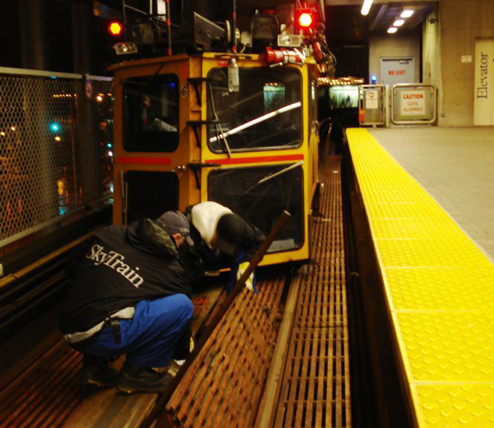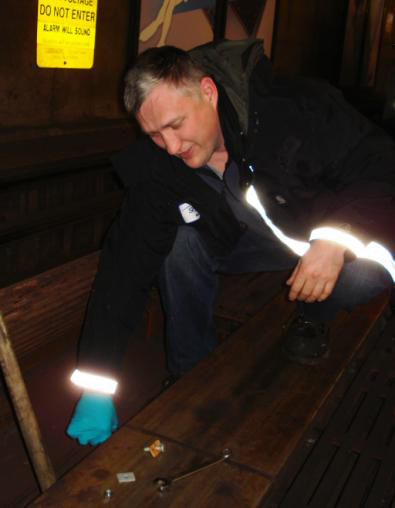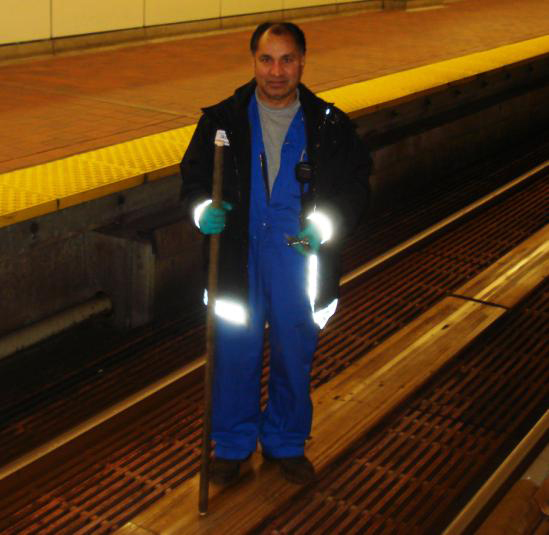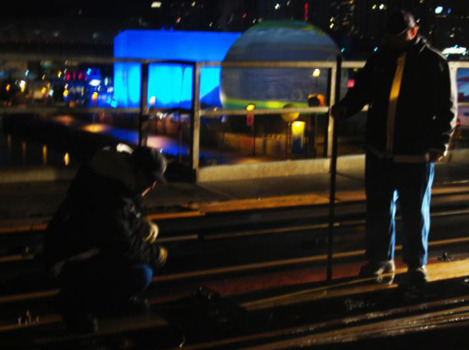The night shift on the SkyTrain guideway
The night shift on the SkyTrain guideway

This article is by Dave Miller, guideway supervisor for the British Columbia Rapid Transit Company (that’s our subsidiary in charge of WCE and Expo & Millennium Line!) As you’ll soon see, it’s all about working on the SkyTrain guideway late at night.
Michael Chernyh, Guideway Serviceperson and Carson Schmidt, Guideway Technician have signed up for the Guideway Olympic Response coverage at Waterfront SkyTrain Station this week. It is 4 p.m. and it’s time to get ready for work.
Pack the lunch bucket, fill the thermos and hit the road because this is an extended shift and Carson and Michael need to relieve the day shift crew at Waterfront Station in a seamless turnover. Plus, the day shift guys are eager to get home to catch the day’s Olympic highlights on the tube. They’d heard the roar of cheering Canadian fans echoing through high-rises in downtown Vancouver every time Canada potted a goal in the 7-3 win over Russia in Men’s Hockey.
Back on the guideway, two other Response Crews are covering the system, one at Commercial-Broadway Station and another at SkyTrain’s Operations and Maintenance Centre (OMC) for points east. These crews are ready to respond to any problem in the guideway within minutes. They are equipped with spare parts, several specialized cleanup and repair kits and linear induction motor (LIM) tapping sticks.

At 2:15 a.m. the last train leaves Waterfront Station and Carson and Michael board a Speeder at the Waterfront tail-track for a patrol to Commercial-Broadway and back. During this shift, they will be focusing on the LIM reaction rail around the stations where the trains generate the greatest thrust.
It’s a big job. Up to 100 LIM panels will be checked at each station platform and there are 36 cap bolts securing each LIM cap panel to the back-iron sleepers. Using a LIM tapping stick, they tap the aluminium LIM cap and listen for any loose cap bolts. A loose cap bolt will snap as the LIM cap is tapped. If the cap bolts are really loose, the bolt, nut and washer will jingle like change in your pocket, making it easy to identify which cap bolts need to be repaired or replaced.
Once Carson gets his Occupancy Permit implemented by Control, he heads down the out-bound guideway (the lower level of the Dunsmuir Tunnel) to Main Street–Science World SkyTrain Station. He also authorizes a couple of cleaning crews to access the guideway within his area.

One crew cleans Waterfront & Burrard Stations while the other cleans Granville & Stadium-Chinatown Stations. While in the guideway, the cleaners will remove everything from newspapers, plastic bags, and pop cans … you name it. They will also recover passengers’ belongings like iPods, cell phones, and cameras that could not be safely recovered by staff during the service day.
At the same time, three other Speeder crews are out on the system patrolling the track, performing similar duties and ensuring that all is good for morning service. The Speeders will use the few hours the track is closed to inspect the wayside components and lubricate the track switches.

The Speeder crews are also keeping an eye on the power rail, checking for burns, pull-a-parts or meltdowns at the splice bar. The power rail and the expansion joints are visually inspected every two weeks, but during the Olympics, the Speeder crews will be checking them every two or three nights.
Before dawn, the cleaning crews complete their work and the other Speeders return to the OMC. Carson and Michael head back to the Waterfront tail-track where the Speeder will be stored until the next night shift. Once staff and equipment are confirmed clear of the guideway and the SkyTrain system can safely operate, the Occupancy Permit is cancelled. But that’s not the end of Carson and Michael’s shift. They will remain in the downtown core ready to respond to any problems in the guideway until the day shift crew arrives at about 7 a.m.






I always wondered what goes on at night. This really shows the value of the nightly closures and possibly why future track enhancements should include a third track budget if we want 24hr operation.
Perhaps one question I have about Expo vs Canada Line is track maintenance cost. Is the linear induction cheaper to maintain? I realize the Canada Line is just 6 months old, so the comparison isn’t fair at this point.
Interesting! I will send your question along for an answer this week — I think everybody is quite busy at the moment and will miss getting me an answer if I send it out today!
Or there could be 24 hr service for one day/night a week, such as Friday or Saturday nights. Times when people party and stay out longer in downtown. I think tomorrow’s Canada Line service shows that this is certainly possible, even if it can’t be achieved 7 days a week.
Least it’s kinda close to the skytrain series request! But can you do a walk through in OMC?
What do they do with passengers’ belongings such as iPods, cameras and cell phones that they recover from the guideway?
Presumably get turned into lost property at Stadium like everything else.
So that’s what a speeder looks like, I tried to google it but couldn’t find the real picture.
Cool. I love learning about the mechanics of skytrain – the “behind the scenes” stuff. The workings of Alcatel SelTrac (Skytrain’s electronic moving-block control system which drives the cars automatically, and maintains safe distances between them), the linear induction drive systems (hmmph – switched-in resistors controlling field current on the mk1 trains! so that’s what makes the stepped acceleration sound), and particularly the -amazing- amount of professionalism and organization that is put into the prevention and solution of problems along the lines. Cool stuff.
One question I’ve had for a while – what makes the “popping” sound that is often heard coming from the guideway after a train has passed? Is this expansion and contraction of the metals? Caused by heat? Mechanical stress of the train propelling itself?…
Thanks for the write-up!
Kelvin:
If I’m thinking of the same sound that you’re referring to (which I often hear a minute or two ahead of a train), I wonder if it could be the LIM magnets switching on and off as they’re pulling the next train along the track?
While we’re on the subject of Skytrain sounds. Has anyone else noticed the Cur-chunk noise outbound trains consistently make during boarding at Edmons station? Any idea what it is? Maybe some kind of reset? It’s the only station if memory serves where this happens and I’ve always wondered!
I have answers about the sounds!
It is the linear motor track reaction rail expanding and contracting slightly with the temperature changes.
It is the master Vehicle On-Board Computer(VOBC) handing over to another VOBC computer, by design, at EDO every trip. The clunk heard is the track brakes (emergency brakes) being applied to the running rail during the 3 second VOBC handover.
Jhenifer, Do you think skytrain would write up more info about how the trains work, and maybe some pics of the undercarriages of the trains?
What causes the mk1 trains to get the acceleration sound that it produces as the train leaves a station that the mk2 trains don’t have?
Tyler: I sure hope so! I can certainly let them know that you are interested in hearing more.
Jhen, Oops. I meant to ask why do the Mark 1 trains produce a different acceleration sound than the Mark 11’s
Ric: here’s the answer from SkyTrain.
;-): Long time coming, but here’s the response from my contacts at SkyTrain.
One more thing, in case you’re interested: Dave Miller also passed along a photo of a speeder and a bit more info on it.
See the photo by clicking here!
Jhen, if the expo and millennium line can share the same trains, why can’t the canada line trains be used on the expo/millennium lines as well as why can’t the expo/millennium line trains be used on the canada line? From what I know aren’t all trains are electric, automated and driven by a linear induction motor.
Ric:
In fact, the Canada Line does not use linear induction motor technology to drive its trains, so they are not interchangeable with the Expo/Millennium Line cars.
What does the Canada line use to drive its trains then?
Why was the technology changed?
Ric, there was a bidding process to build the Canada Line, and to make a long story short, Bombardier (Skytrain)did not win. Not a big deal imo, there is no connection between the Canada Line and the older lines, and we in Vancouver are kind of unique compared to other cities. Cities like Calgary, Denver, Salt Lake all have their downtowns in the very centre of their cities. Downtown Vancouver otoh is a peninsula on a peninsula.. It isn’t the geographic centre of the region, so the fact that the Canada Line uses a different type of train is kind of irrelevant; they were never going to connect as they do in Portland, LA, or San Jose where “downtown” is more central than it is in Greater Vancouver.
See http://en.wikipedia.org/wiki/Canada_Line for answers about the Canada Line
(PS to Jhenifer… Skytrain uses Seltrac (http://en.wikipedia.org/wiki/SelTrac) Does the Canada Line use Seltrac?)
In addition to propulsion differences, the Canada Line and Expo/Millenium lines never meet. The lines cross at the Bay and are close at Waterfront, but the rails never touch and prevent an easy transfer of the railcars.
While both CLine and the Mark vehicles are both electric. The propulsion “means” or application differ. Canada Line uses the electricity to spin an electric motor that connects to an axle. The LIM based Mark vehicles have NO motor. The center aluminum strip is actually half the motor (stator) “unrolled” on the rail bed. The Mark vehicles works like Japanese magnetic trains to move forward and backwards. But to save money, standard train wheels are used for the suspension, instead of magnetic fields. As the LIM design has no moving parts for the propulsion, it was believed to save maintenance costs.
So does this mean Canada Line vehicles can run on Expo/Millenium tracks, but Mark vehicles cannot run on Canada Line? I guess platform width and train length would cause some issues.
I asked this question also at open houses and it was explained to me the LIM technology was very proprietary. However Canada Line was using common subway parts to save money.
I think the Bombardier technology was considered during the bidding process. Was cost the deciding factor to move away from LIM technology? I guess requirement to tunnel the entire Vancouver segment really added to the cost. Also the Richmond segment was originally going to be single-tracked or at grade in early designs.
I’m glad to hear the Mark 1 vehicles last so long. Light weight Aluminum was considered space age back 25 years ago. Rust proof, the only issue with the Mark 1 was the lack of heaters when cold weather hits and doors freeze open. I guess without sea water, the Mark 1’s don’t have the cracking problems like the Seabus. Wow, just look at the age of our historic streetcars at just over double 25 years.
Dave 2:
I have asked ProTrans BC, and the Canada Line DOES use SelTrac!
Why didn’t the Canada Line use canadian trains from bombardier and had to go with korean trains from Hyundai Rotem?
BTW, why didn’t the Canada Line use linear induction motor technology to drive its trains instead of electric motors? Is there a benefit of using electric motors over linear induction motors?
@Ric
When the different companies bid to build to Canada Line in the P3 deal. The Bombardier group lost. Therefore we did not get linear induction motored trains. In other words we cheaped out on the line :(
No electric motors are not as good as liner induction motors. The biggest benefit to LIM is that it can climb a steeper hill and hit top speed quicker.
Theoretically Bombardier bid was cheaper as it would have allowed them to use the existing maintenance facility at Edmonds. But they didn’t allow Bombardier to use that part in their bid.
True, true.
For me, every time I ride the Canada Line, the train pretty much squeals on every single curve, especially on the sharper curves. I remember at the Q.E. park section, the train was pretty much squealing the entire curve. That doesn’t happen for the SkyTrain, or at least not as noticeable as the Canada Line (haven’t ridden either lines recently).
I think it would have been better if Bombardier won the bid instead because there would be more options, like actually connecting the three lines together. And maintenance would be easier.
Is the track size the same for Canada Line and SkyTrain?
Btw, all the enunciator announcements say “SkyTrain Station” when it gets near Canada Line stations, even though it isn’t SkyTrain.
One thing amusing me right now is how on the #9 or #99 bus, when it nears Commercial Broadway Station, it says “Broadway SkyTrain Station”. Then at Cambie and Broadway – City Hall, it says “Cambie Street – and Broadway SkyTrain Station — transfer to the Canada Line”
So which one is supposed to be “Broadway SkyTrain Station”? lol =P
That could be potentially confusing if somebody fell asleep and/or didn’t pay attention to the “transfer to the Canada Line” part of the announcement
@Andrew
The track gauges are different between the Canada Line and the older Skytrain lines. So no chance of ever converting the Canada Line.
As for the squealing section around Queen Elizabeth Park. Why you here it there and not so much on the older Lines. In the older lines they spent the extra money to bank a lot of the turns. With the Canada Line to save money they could of spent the extra money to bank the turn. But they didn’t. So we got flat bent turns. Which with trains causes the wheels to squeal. Same thing actually happens on the older lines in those area where the bank isn’t in the track.
It’s because the Canada line is axle based and it isn’t designed tfor that speed or tight turns. The Bombardier technology trains are actually a dumbed down version of maglev. Wheels were put in to provide stability.
Andrew S:
As I’ve maybe said before, we generally refer to our rail services as SkyTrain — ergo, Expo/Mill/Canada Lines are all lines of SkyTrain. Most people just call them all SkyTrain lines anyway so this makes it less confusing. And yes, I do know this is inconsistently applied!
Ohh… okay. Thanks for correcting me!
Every time I ride the Canada Line the train squeals on every curve. However, when I ride Expo or Millenium line there is no squeal on the curves. When I ride the canada line I also notice that each time the train crosses where the track splits it sort of produces a click sound. However, I don’t notice this on the expo/millenium line.
Why do the canada line trains squeal on curves?
Why are there what I call click sounds each time a canada line train crosses where the track splits?
It looks like that the Hyundai Rotem trains aren’t as good as the UTDC/Bombardier trains as it seems these problems aren’t noticed on the expo/millenium lines. It also seems like that linear induction motor technology is better than electric motors as I notice that expo/millenium line trains are actually faster than the canada line trains.
I’m going to take a guess on the Canada Line squeal…..
a) Could it be that the tracks are still new and take more months to be broken in?
b) Skytrain uses an articulating “truck” (if that’s what they are called) that turns into the curve to minimize wear and tear, as well as noise. I remember seeing a brochure about this technology when the Mk1’s were introduced in the 80’s. Canada Line may lack this complicated set up to save design costs, but have higher maintenance issues over the years.
Ric: here’s the answer from Canada Line.
We all know that Skytrain works by magnetic propulsion…. however, what would happen if put more magnets on it…. could we achieve Mach 8?
sono…
[…]Sites of interest we like to link to[…]…
[…] longer if the staff weren’t so busy. If you’re left reading this wanting more, this past post has some great info and images of what goes on during the night shift at SkyTrain Control. […]
Dear Buzzer Blog,
This is a question for canada line and skytrain:
But what happens to all the newspaper that is found on the trains.
For the canada line, i always see a person come on the train at the station and clean up the litter in the train.
But why not clean it up at night instead? Also one time i was taking a canada line and a passenger was drinking coffee on the train but it spilled all over the floor and then i didnt know what to do. What do i do if this happens next time i take the train?
Does the crew shut off the power rail during the nightly maintenance?
Jimmy: Yep!
If someone jumped on to the tracks on the Expo line, how does that alarm set off?
Jim: I believe there are weight sensitive plates that trigger the alarm.
Depends on the station. Some stations use pressure pads between the rails. Sometimes they don’t work….
Greetings Jhenifer,
I notice this post is about a year out of date :-)
However, it is not closed and I feel enticed to ask a long-wondered question.
It’s a SelTrac question.
SelTrac has gone through three different generations of development, starting with ITT-SEL in Germany, then Alcatel, and then now Thales as it’s vendor.
SkyTrain (Expo Line) is one of the oldest installs of SelTrac. How much of SkyTrain is still using the original 1980s equipment? Things like the inductive loop repeaters and some wayside equipment must still be of an older age.
Thanks :D
Jhenifer is actually with the City of Vancouver now, but Brian, I’ll see if I can get an answer to your question from the SkyTrain folks!
EDIT: Here’s the answer from SkyTrain:
Hello my name is Almir, I would like to know how the inspection of the rails has been done, and how is the inspection of the subway trucks done?
And how do I become part of this team?
thank you
Hi Almir, our jobs are posted at http://www.translink.ca/careers so you’ll want to keep your eyes peeled on that page for careers with British Columbia Rapid Transit Company, our subsidiary responsible for SkyTrain.